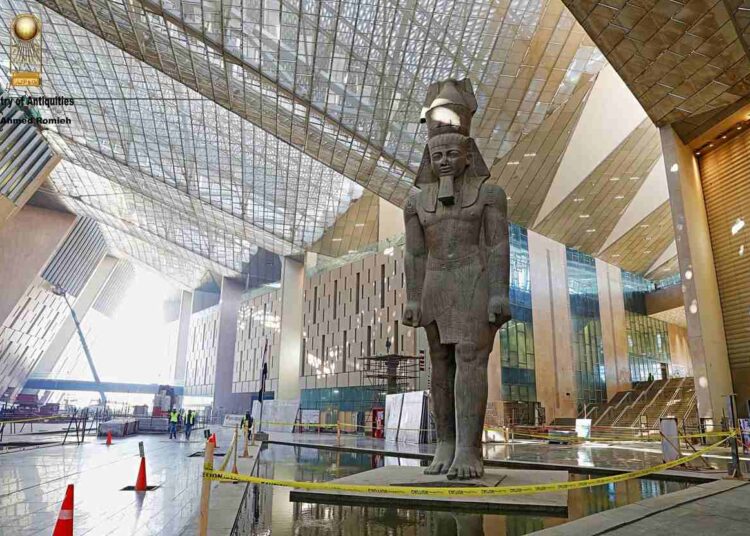Many people all over the world are waiting for the opening of the Grand Egyptian Museum (GEM) at the foot of the pyramids. The GEM is not only the largest museum in the world dedicated to a single civilisation, but also it is the first green building in Egypt.
As Egypt is hosting the COP27 in Sharm el-Sheikh starting today until 18 Nov, the Egyptian Mail looks at the reasons for selecting the GEM as the first eco-friendly museum in the country.
On October 27, the GEM received the Gold Certificate for Green Building and Sustainability in accordance with the Egyptian Green Pyramid System.
The Green Pyramid Certificate is awarded by the Housing and Building National Research Centre in Egypt for buildings that adopt environmentally friendly strategies and achieve sustainable development.
GEM project supervisor-general Atef Moftah said the museum and the Centre worked together to prepare a guide to assess the building in accordance with conditions of the highest international standards.
Centre board chairman Khaled Al-Dhahabi said that the museum was built in the most modern architectural style in the world, using cutting-edge technologies that achieve sustainability. It is one of the largest cultural, archaeological and tourism projects in modern history.
In September, the Arab Water Council announced the winners of the Environment and Development Forum (EDF) award, which is organised by the council, on the sidelines of the forum held in Cairo under the title ‘The Road to Sharm el-Sheikh – Conference of the Parties to the United Nations Framework Convention on Climate Change’.
Thirty-one contestants from Arab countries submitted projects for the award, which was launched under the title: ‘Best Practices in the field of Environment and Development’ with focus on Best Climate Change Response Practices, in the five areas of the award, namely; Waste Reduction Award, Towards Net Zero Award, Innovative Climate Change Adaptation/Mitigation Product Award, Green Building Award and Best Water Savings and Reuse Award.
The GEM won the competition as the best project in the field of ‘Green Building’.
Moftah highlighted the raising of the efficiency of water and energy conservation within the museum by reusing water and reducing its consumption, especially those used in agriculture, as well as the measurement and detection system for leakage, reducing different temperatures, and using renewable energy sources.
He pointed out that adopting the museum as a green building also includes ways of managing it by improving ventilation performance and using natural ventilation and air flow calculations that must comply with the minimum required ventilation rates.
Moftah referred to the renewal of the ISO certificates obtained by the GEM during September 2020 until 2022. These are the international certificate in the field of occupational safety and health (ISO 45001:2018), the international certificate in the field of environmental management (ISO 14001), and the international certificate for quality systems (ISO 9001).
The museum has obtained the ISO/PAS 45005:2020 certificate, which is concerned with managing risks arising from the Covid-19 to protect health, safety and welfare related to work.
GEM International Relations Coordinator Menna Allah Taher said the museum takes into account the achievement of sustainable development goals in its various environmental, cultural and economic dimensions. There are services for the public in means of transport and the use of electric cars inside it, saving electric energy consumption and rationalising water consumption by recycling it.
She added that there are pollution monitoring stations in the vicinity of the museum to monitor pollution and measure ratios.
Moreover, other services provided for visitors are waiting areas, achieving full access for people of determination, and the use of natural ventilation and natural lighting, which is available in the museum’s lobby where King Ramses II receives his visitors.
Japan has been cooperating, as the major partner, for the construction of the GEM through providing necessary financing and technical cooperation. It is regarded as one of the main and most important symbols of the Egyptian-Japanese long history of cooperation.
Spokeswoman for the Ministry of Tourism and Antiquities Soha Bahgat said that the ministry is following a plan to convert all facilities of tourism and antiquities in Egypt into green that are environmentally friendly.
The ministry is also training its employees on ways to preserve the environment, within the framework of the general direction of the state to transform into a green economy within the vision of 2030, as well as in light of Egypt’s hosting the climate summit.






Discussion about this post